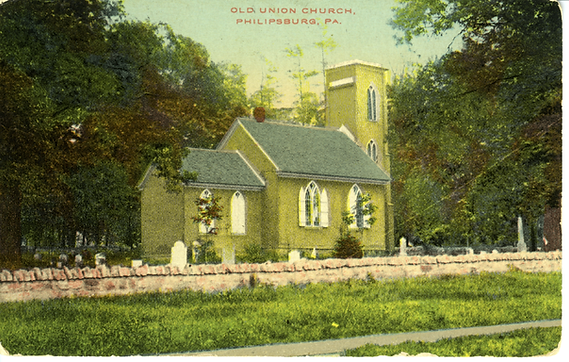
Mud Church
2-98 N 7th St, Philipsburg, PA 16866

Written By: Chris Watson
When surveyor Charles Treziyulny laid out the town of Philipsburg for the firm of John Leigh Philips and Brothers of Manchester, England, he neglected to make a provision for a burial ground. Circa 1803-04, George and Rosalie Shultz's infant daughter Sally died from the croup. The Shultz's buried her on their partially cleared out lot in the shade of what is now known as the "Founders Oak" which began its life circa 1640.
The Shultz's gave other settlers permission to bury their loved ones in their "hallowed ground." Seeing the need for a community burial ground, Mr. Philips traded the Shultz's their out lot for ground in Decatur Township, Clearfield Co. where they lived for the remainder of their lives.
Mr. Shultz is often referred to as one of the "original twelve settlers" of 1797. However, there were probably at least twenty-five men, women and children in the group of original settlers. Members of this original group buried here are: George Shultz (1761-1844); Rosalie Barth Shultz (1770-1842); Sarah Densel Simier (died 1822); and Lovinia Simler Turner (died ca. 1818).
When you walk through the burial ground and see large gaps between tombstones, this space isn't empty. It's filled with unmarked graves. In fact, there are well over 500 people buried there.
Due to its overcrowded condition, an ordinance was passed in 1872 prohibiting further burials because "almost without exception each new burial unearths some poor unknown soul." After 1872, burials were allowed only by special permission, usually in the case of a spouse already being buried there. The last known burial was John Hudson in 1907.
In 1819 or 1820, a subscription was made that stated: "We the subscribers wish to have a house built which will answer the double purpose of a school and place of worship to be free for moral regular preachers of the gospel of all denominations." Area residents donated their money, time and materials and the building was erected on the burial ground lot.
By an agreement of all citizens, the Methodists, having a greater membership than any other denomination, and likewise the only one that was regularly supplied with preaching, were accorded occupancy of the building on the Sabbath at 11:00 a.m. The time for evening worship was "by early candlelight." Many of the present wall sconces are relics from the original "Meeting House."
Prior to the 1834 public school laws, no one was forced to attend school and teaching was provided through "subscription schools". Each student had to pay tuition and supply all their own books, paper, pencils, pen, etc. Children were only taught the three "R' s": reading, writing and arithmetic.
In 1841, another subscription was made for the purpose of "repairing and improving" the church. The subscription stated: "The proposed improvements are calculated to require an expenditure of three hundred dollars, the roof is to be new shingled and tin spouts added, the outside of the Church to be rough cast, the inside and ceiling to be lathed & plastered, the gallery and inside porch to be removed and a new porch with two windows to be constructed outside, on the West end an addition to be made to contain the pulpit, communion table and a vestry, the body of the Church to be pewed, the belfry to be repaired and a bell added". The "gallery and inside porch" would today be called a balcony and a vestibule. The rough cast plaster is where the church derived its name "The Old Mud Church."
Similar to the first subscription, area residents donated their money, time and materials to the project. Hardman and Sophia Philips are believed to have significantly influenced the final design. Mr. Philips' employees we're engaged to do much of the work. When the renovations were finished in the fall of 1842, the cost greatly exceeded the original estimate of $300.
Although numerous people failed to make their promised subscriptions, the Philps' were blamed for making changes which were "unnecessary and uncalled for". For instance, "the outside porch with two windows" turned into a crenellated bell tower with hand carved finials. Also, the shape of the windows was changed to an intricate gothic design. The quatrefoils at the top of the windows are said to have been carved with a penknife by Samuel Burris, one of Mr. Philips' employees.
Since Mr. Philips absorbed the cost of the overrun, he attempted to claim the church as a Protestant Episcopal Church. Perhaps his motivation was because two of his children are interred in the burial ground. Many local residents strongly opposed Mr Philips' plan and desired the church to remain free to all denominations. A third subscription was made to hire an attorney to fight Mr. Philips. After a long and tedious lawsuit, Judge Woodward considered the proceedings entirely unwarranted and because the judgment would irregular to both the plaintiff and defendant, he laid the case aside.
The present appearance of the Union Church, both interior and exterior, most accurately represent the work of 1841-42. There have been no structural changes and the original flooring, window glass, pews, bell and brass whale oil lamps remain. The pews were built by Christian Emigh at a cost of $60. The church bell came from the Philipsburg Screw Factory, one of the first screw factories in the United States.
Through the years, the Union Church continued to shelter the services of the Episcopalians, Methodists, Presbyterians, Lutherans and worshippers of other denominations until the 1920s when the Free Methodists were the last to hold regular services there.
In 1978, the Union Church was placed on the National Register of Historic Places by the United States Department of interior, Washington, D.C.